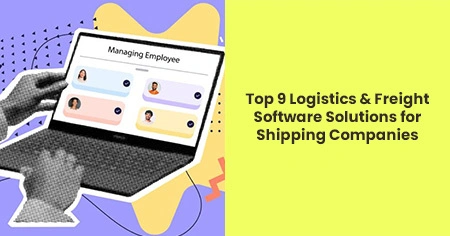Logistics and freight software solutions help businesses automate tasks, improve tracking accuracy, and streamline fleet operations. These tools reduce manual work, cut unnecessary costs, and keep operations running smoothly.
In this article, we’ll explore top logistics and freight software solutions that help shipping companies work faster, smarter, and more profitably.
Transportation Management Systems (TMS) for End-to-End Operations
Managing shipments manually in the current logistics industry is nearly impossible. It is mainly due to how delays, miscommunication, and elevated costs can readily disrupt certain operations. A Transportation Management System (TMS) helps shipping companies to fully automate and optimize all aspects, such as route preparation to real-time monitoring and billing.
Here’s how a TMS helps:
- Cuts cost and saves time: Instead of searching for shipments manually, a TMS automates the process of comparing also, secures freight quotes, and highly optimizes delivery routes in seconds.
- Strengthens real-time tracking: Logistics managers, through GPS and data analytics, can now track shipments in real-time, foreseeing delays that could create problems and solving them before they occur.
- Improves customer satisfaction: Customers are informed and updated with their orders about effective tracking and automated notifications, leading to a reduction in inquiries and complaints.
- Integrates with other logistics resources: A TMS connects with warehousing, freight, and dispatch software to provide an integrated supply chain.
In short, for freight carriers, 3PLs, and large-scale logistics providers, a TMS isn’t just a convenience; it is fundamentally a necessity for constantly remaining competitive and profitable.
Dispatch Software for Smarter Fleet Coordination
Coordinating a fleet by hand isn’t just time intensive — it’s impossible at scale. Fleet managers have to handle scheduling drivers, assigning loads, optimizing routes, and dealing with last-minute changes manually without dispatch software. It causes delays, miscommunication, and exhausted resources.
A well-built dispatch software system enables businesses to maximize operational efficiency, mitigate inefficiencies, and boost service reliability. It automates the vehicle assignment process, optimizes delivery routes, and provides real-time updates, enabling dispatchers to respond to delays or changes to a route on the fly. Some of the essential benefits of this software are as follows:
- Features multi-vehicle route optimization to maximize fuel efficiency and avoid unnecessary delays.
- Decreases wasted driver hours and vehicle wear and tear, driving down operational costs.
- Enhances customer service by ensuring timely deliveries and providing real-time status updates.
- Provides key insight into fleet efficiency, including idle time, cost per stop, miles per delivery, productivity, etc.
- Integrates with GPS, communication tools, and APIs. It enables fleets to link to third-party software for custom solutions.
Businesses can improve efficiency and maximize profitability while also building strong customer relationships by automating dispatch and tracking fleet performance. A well-integrated dispatch system helps a fleet to run on top gear, which translates into faster deliveries, lower costs, and better decision-making.
Warehouse Management Systems (WMS) for Inventory Control
This is where a warehouse management system (WMS) comes into the picture. It lets businesses track inventory in real-time. It automates picking, packing, and shipping, cutting down on human error and speeding up fulfillment. A WMS enables both faster movement of products and better space utilization by optimizing warehouse layout and storage.
It also helps reduce losses from misplaced or expired inventory by keeping track of detailed records of stock and movement. It integrates with freight and dispatch systems, ensuring smooth coordination between warehousing and shipping operations.
ELD Software for Compliance and Driver Efficiency
Tracking driver hours and being compliant with the regulations is a non-negotiable for truck companies. Paper logs can be inaccurate, leaving businesses with the possibility of violations, fines, and license suspensions.
ELD software automatically tracks hours-of-service (HOS). It helps keep drivers within legal limits and prevents fatigue-related perils. The software specifically:
- Automatically plugs into the truck’s engine to know when it is moving.
- Lets drivers record their duty status, such as On-duty, Off-duty, Drive, or Sleeper Berth, and the driving time automatically records when the truck moves.
- It shows a visual record of duty status (RODS) so drivers can quickly check what hours they have left in a day.
- Allows the transmission of standardized data to law enforcement by multiple means (e.g. wireless web services, USB, or Bluetooth) for rapid inspection compliance.
With ELD software, trucking companies can reduce paperwork, boost safety, and avoid costly penalties, ensuring their operations run smoothly and are compliant.
Fleet Maintenance Software for Vehicle Health Monitoring
Needless to say, unplanned vehicle breakdowns can derail shipping schedules, prolong delivery, and rack up unexpected repair costs. Fortunately, fleet maintenance software allows companies to get ahead of problems by automating maintenance schedules to trigger reminders and alerts for oil changes, tire checks, and inspections—they can catch problems before they grow.
This allows them to avoid reacting to breakdowns and even prevent any breakdowns whatsoever. It also tracks fuel consumption, engine diagnostics, and driver behavior, empowering businesses to combat fuel wastage and reduce wear and tear. When vehicles operate optimally, companies save money and achieve dependability.
The goal is to ensure that a properly maintained fleet will deliver fewer delays, lower costs, and a safer road at the end of the day. Keeping trucks in tip-top condition also guarantees that each shipment is delivered on time, free of expensive disruptions.
Freight Management Software for Load Planning
Poor load planning leads to empty truck space, higher fuel costs, and inefficient deliveries. Without a system in place, logistics managers spend hours manually assigning loads, adjusting weight distribution, and trying to match shipments with available carriers. This not only slows down operations but also increases costs.
Freight Management Software (FMS) helps shipping companies maximize load efficiency by automating these processes. Instead of relying on guesswork, an FMS uses real-time data and smart algorithms to:
- Optimize truck space: Make sure every truck is running to maximum capacity and not overweight, which leads to fuel waste.
- Match freight with suitable carriers: Determines the most economical shipping routes, transport modes, and any available carriers for delivery.
- Avoid shipment delays: Offers automated scheduling to ensure shipments flow smoothly and arrive on time.
- Enhanced cost control: Enables businesses to check rates against multiple carriers to prevent overpaying on freight shipping.
For instance, an FMS enables a logistics company that transports large volumes of LTL (Less-Than-Truckload) shipments to combine the loads, minimize empty miles, and enhance operational efficiency. Without it, companies risk having underused trucks, little costly last-minute changes and missed delivery deadlines.
Customs Compliance Software for International Shipping
Many budding entrepreneurs assume that shipping across borders is all about loading a truck and hitting the road. But that’s not quite true. Customs regulations, import/export restrictions, and tax requirements can delay shipments, cause expensive fines, or seize goods.
Moreover, mistakes in documentation or incorrect tariff classifications can cause major delays and financial losses. Thankfully, customs compliance software takes the guesswork out of international shipping.
It automates paperwork, calculates duties and taxes, and ensures every shipment meets legal requirements. Instead of manually filling out forms and tracking changing regulations, businesses can speed up clearance times and avoid penalties.
It also integrates into freight and logistics platforms so that all the information and data around customs are seamlessly stored in one place. This way, companies are able to move goods faster, minimize compliance risks, and maintain strong international trade relationships.
Last-Mile Delivery Software for Faster Customer Service
The final leg of a shipment, also known as the last mile, is usually the most time-sensitive, expensive, and uncertain. Traffic delays, drop-off misses, and route inefficiencies can frustrate customers and increase costs.
Last-mile delivery software simplifies delivery, optimizes routes, and provides real-time tracking for businesses. It guarantees drivers the fastest, most efficient journey possible, reducing delays and, ultimately, fuel costs. Customers also receive automated updates and accurate ETAs, enhancing satisfaction and transparency.
This software can also streamline proof of delivery, enabling drivers to record electronic signatures, photos, or QR code confirmations. This decreases contention and ensures that each package is delivered on time to the correct individual.
For shipping companies, faster and more reliable last-mile delivery means happier customers, fewer failed deliveries, and lower operational costs- a win-win for businesses and consumers alike.
Things to Keep in Mind Before Selecting Software for Your Shipping Company
As logistics and freight software can make or break your shipping operations, it is time to choose your software carefully. With the multitude of options out there, you need to assess your individual needs before deciding. Here are a few factors to consider before deciding on a solution:
- Scalable: Make sure the software can expand alongside your business, whether you need to manage a small fleet or massive shipment volumes.
- Integration: Choose software that integrates well with your current TMS, WMS, dispatch system, accounting software, and more.
- User-friendly interface: Complicated software slows down the operations. Choose a system that’s user-friendly and needs little training.
- Real-Time Tracking & Automation: Go for software that provides real-time shipment visibility, automated scheduling of logistical activities, and instant notification to improve workflow.
- Customization and API Support: Some companies require custom features or integrations. So, the software must be flexible and support third-party API connections.
- Security & Compliance: Verify the software's compliance with industry regulations and data security standards, particularly for international shipping.








